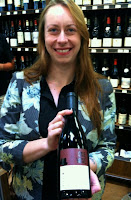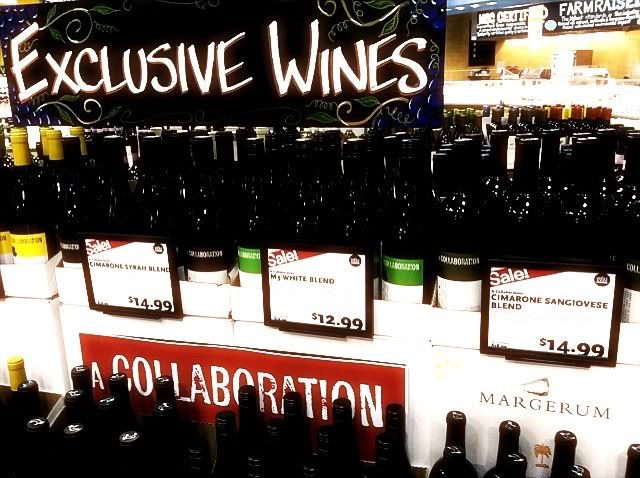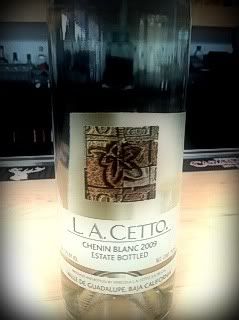The local wine concept is alive and well at
Whole Foods Markets in Southern California. The
One Wine label - available at Southern California Whole Foods stores - is a unique collaboration between Whole Foods Market and local winemakers. It started with WFM’s commitment to providing their customers with products that celebrate the places and stories from which they are created.
The
One Wine label started in 2011 as a partnership with two wineries in Santa Barbara County, and has since blossomed into a mutually beneficial, creative and delectable partnership between Whole Foods Market and over ten of Southern California’s best winemakers. All of the
One Wine releases are small lot wines, typifying the movement of boutique wineries in Santa Barbara County. They are all in limited supply, and only available in Southern California Whole Foods Market stores. They have a habit of disappearing from the shelves quickly, so don't delay in picking up the ones that interest you.
I had the extraordinary opportunity to visit the Whole Foods Market in Venice, CA as they celebrated the five-year anniversary of that store. The new
One Wine releases were poured, with winemakers and representatives of the wineries that made them present to chat about the wines. It was a three-hour drive down to L.A. for them, so their presence was much appreciated.
 |
| Roger Fawcett |
The event was headed up by
Hilary Maler, the Southern Pacific Region Associate Marketing Coordinator for Whole Foods. Joining her was
Roger Fawcett, wine and spirits buyer for the region. Fawcett was excited about the chain's involvement with the
One Wine project. “We are thrilled to partner with our neighboring vineyards to create regional, locally produced blends for our customers,” he said. “Our
One Wine label wines showcase the world-class winemaking taking place in the foothills and valleys that surround our community, and allow our shoppers the opportunity to uncork a range of Southern California’s best wines.”
In case you are unfamiliar with the
One Wine line, participating wineries include Ampelos Cellars, Au Bon Climat Winery, Cimarone Wines, Clendenen Family Winery, Fallbrook Winery, Happy Canyon Vineyards, Hearst Ranch Winery, Hitching Post Winery, Ken Brown Wines, Margerum Wineries, Sextant Wines, South Coast Winery and Stolpman Vineyard. With names like those, you can expect high quality - and they are priced nicely, between $15 and $20 per bottle.
You can get a taste of
One Wine by viewing this mini-documentary.
 |
| Jim Saunders |
One Wine Hearst Ranch Paso Robles Red Blend 2011, $20
Jim Saunders, of
Hearst Ranch Winery, conducted a blind blending session to determine the mix for his
One Wine Red Blend. It turned out that the Whole Foods Market team, led by
Priscilla Vazquez, made a more popular blend than that of the winery staff. Saunders took it in stride and signed off on it, saying, “We get to showcase a lot of different wines in one bottle.”
 |
| Priscilla Vazquez |
He certainly does. The blend is 85% Cabernet Sauvignon, 10% Malbec, 3% Petit Verdot and 2% Petite Sirah. The expressive nose shows big fruit - black cherry and raspberry - with a touch of mocha. Blackberry and currant flavors dominate a palate which is both elegant and powerful. The tannins make themselves known in this muscular wine, and the alcohol stands at 14.1% abv. Saunders says, “We use different shades of oak for the different varieties in the blend. We love it. We made less than 500 cases, so it probably won’t last too long on the shelves.”
 |
| Gray Hartley |
One Wine Hitching Post Red Blend 2010, $15
Gray Hartley is one half of the winemaking team at
Hitching Post Winery. He and
Frank Ostini make some fairly legendary Pinot Noir, and are also doing some nice things with a grape Hartley calls a “Pinot Noir wannabe.”
The Valdiguié grape - VAL dee gee ay - was once known as Napa Gamay, due to its similarity to the grape of Beaujolais. What it really bears a resemblance to is Pinot Noir. The
One Wine Hitching Post Red Blend is 51% Valdiguié, 42% Merlot and 7% Cabernet Franc, so the grape’s presence is easily noticed. Hartley leans in and softens his already soft voice to explain how Valdiguié “acts as a conductor, tapping the baton and bringing the other elements of the wine together in symphony. It brings out the best the other grapes have to offer.”
The wine is fermented and aged in neutral oak barrels and comes to an easy-drinking 13.8% abv. The smoky, raspberry/floral nose and slightly tart palate immediately makes me think of a really bold Pinot Noir.
When Hartley told me how the
One Wine experience has spurred sales of other Hitching Post wines, WFM’s Roger Fawcett jumped in. "The
One Wine project is a great way to showcase the region's winemakers, and the extra visibility helps move other wines in the wineries' own lines." Hartley responded with an overly sincere, "You're in good hands with Whole Foods Market,” then the kicker: “Oh, that's an Allstate commercial! Seriously, the friendships we've built with Whole Foods are close."
One Wine Hitching Post Rosé 2012, $15
The pink side of Valdiguié is about as pink as it gets. It’s deeply tinted - like the salmon Hartley caught in his earlier career as a fisherman. The mix this time is 48% Valdiguié , 47% Grenache and 5% Pinot Noir. Hartley says there’s isn’t a lot of Valdiguié available in California. “I dare you to try and find some! Ours comes from French Camp Vineyard in Paso Robles.” It has a very modest 13.1% abv number and is released to Whole Foods for
One Wine before they do their own Hitching Post version.
Showing the mark of a good rosé, the wine has great acidity. Again, the presence of the Valdiguié comes through in the flavors that are as dark as the color. Again, Hartley lifts his imaginary baton in explaining how the grape inspires the other fruit. “All the grapes are co-fermented, half in steel and half in neutral oak. The fermentation of Valdiguié is quite something to see. It really roils in the barrel. Puts on a show."
 |
| Doug Margerum |
One Wine Happy Canyon Merlot 2010, $18
Doug Margerum was one of the original winemakers involved in the
One Wine series, back when it was called A Collaboration. He showed up on his birthday with no candles awaiting him, but he lit up like one when he started talking about his wines.
The
One Wine Happy Canyon Merlot blends 75% Merlot, 20% Cabernet Sauvignon, 2% Malbec, 2% Cabernet Franc and 1% Petit Verdot. Margerum says he used Bordelaise punchdowns to keep the grape skins in contact with the juice and sent the wine into small oak barriques for eleven months. The Merlot was fermented in steel. The wine offers a dusty, floral nose and is fresh in a way that is Margerum’s calling card. Bright cherry flavor and great acidity are your reward for working the corkscrew. This wine - as with all the
One Wine selections - was subject to a blending panel. Margerum admits that he cheated the process a bit to get the blend he wanted, but all’s well that ends this well.
One Wine Margerum White Blend 2012, $16
Margerum’s white wine entry to the
One Wine line is an inventive blend of Sauvignon Blanc, Chenin Blanc and Riesling. "
I wouldn't do it, but
they can," Margerum says, with a nod toward the WFM crew. "For them, all bets are off the table." He likes more traditional blends, so something this riotous would not appear in his portfolio. "I'd be more inclined to mix Sauvignon Blanc and Semillon." The wine is very mineral driven, with pears and apples aplenty, but the minerals are really the story. It's a delicious and interesting wine. Quite refreshing, too.
 |
| Marissa Beverly |
One Wine Clendenen Family Winery Italian Red Blend, $15
Representing
Clendenen Family Winery was
Marissa Beverly. She tasted me through the
One Wine Italian Red Blend, made of 60% Nebbiolo and 40% Barbera grapes at only 13.5% abv. The grapes come from Bien Nacido Vineyard, a very special plot of Santa Maria Valley land, in blocks planted especially for winemaker
Jim Clendenen. It's a non-vintage mix of mainly '05 and '06 wine. The nose shows cherries and dark berries and hits the palate with great acidity and tart raspberry flavors.
One Wine Au Bon Climat Winery Pinot Gris 2012, $18
Clendenen's Pinot Gris is a 100% varietal wine made from grapes grown in the Sierra Madre Vineyard in the Santa Maria Valley. The alcohol is quite restrained - just 12.3% abv - and the wine sees full malolactic fermentation, which converts the malic acid into lactic acid and gives a fuller mouthfeel.
Whole cluster pressed, the wine is fermented and aged six months in neutral oak. The bouquet is full of fruit with a great mineral profile. Soft, smoky fruit decorates the palate and there is just a touch of creamy oak on the finish. Pair it with salmon, lobster or crabs and you'll be happy.
Follow Randy Fuller on Twitter







